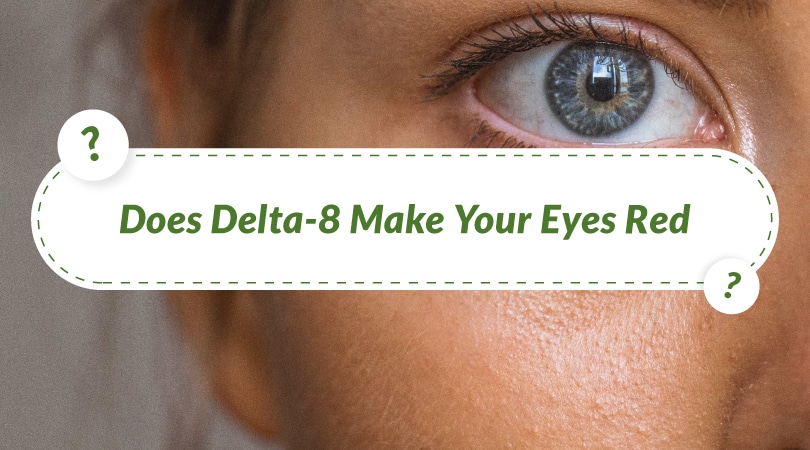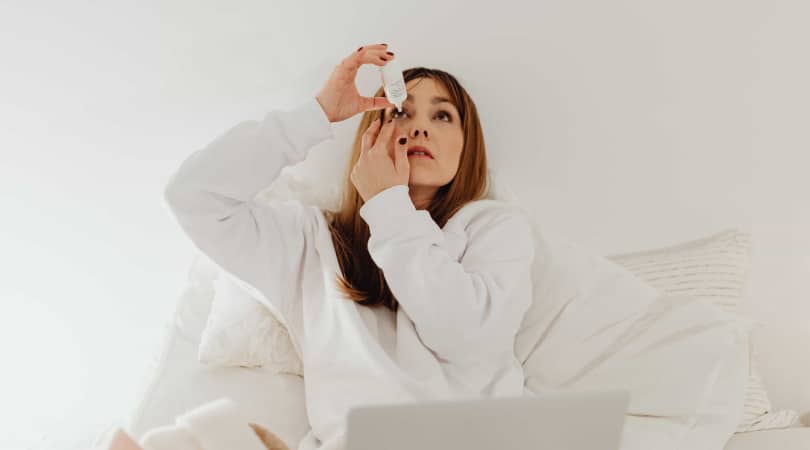
Does Delta-8 THC Make Your Eyes Red?
Red eyes can be an unwanted side effect for those seeking to enjoy the calming properties of cannabis. If you find yourself concerned about this side effect preventing you from trying Delta-8 THC, don’t let it discourage you.
Delta-8 THC can have a positive impact on your well-being, so let’s delve into how to use it, the science behind red eyes when consuming cannabis and its derivatives, and how to manage this common concern.

What Is Delta-8 THC?
First things first, let’s see what exactly is Delta-8 THC.
Delta-8 THC is an innate cannabinoid present in hemp and marijuana plants. It’s worth noting that the cannabis plant encompasses a diverse array of over 100 cannabinoids, each bearing its own distinctive characteristics and effects.
Unlike CBD, which is non-psychoactive, Delta-8 THC does produce a mild high. However, compared to other THC products, it offers a more subtle experience, making it an excellent choice for relaxation, sleep aid, and anxiety reduction. This mild effect also reduces the likelihood of adverse reactions such as paranoia or nausea.
Why Does Cannabis Make Your Eyes Red?
It was previously believed that red eyes were due to irritation caused by smoke.
In reality, Tetrahydrocannabinol (THC), a psychoactive cannabinoid, interacts with cannabinoid receptors found throughout the body, including the eyes, which are rich in these receptors as part of the endocannabinoid system.
When THC connects with the eye’s receptors, it makes blood vessels, especially those on the eye’s surface, widen.
Because the blood vessels in your eyes get bigger, they let more blood flow through. This extra blood flow makes your eyes look red, just like when you blush or when you have a sunburn.
In sum, the dilation caused by THC leads to increased blood flow to the eye’s blood vessels, which, in turn, results in redness.
Red Eyes: Delta-8 THC vs. CBD
The question of whether Delta-8 THC causes red eyes is a common concern among users.
Unlike CBD, which does not lead to red eyes, THC is known for this distinctive effect. Even in full-spectrum CBD products that contain trace amounts of THC, the levels are generally too low to cause noticeable redness.
So, if you’re wondering whether Delta-8 THC makes your eyes red, the answer is yes, but the same doesn’t apply to CBD.
Keep in mind that full-spectrum CBD products legally contain trace amounts of THC (up to 0.3%), usually too low to cause redness. However, poor-quality products or higher THC levels can lead to red and watery eyes.
To avoid this, choose high-quality products, like those tested by third parties. At Vitality, we ensure accurate ingredients and potency for maximum results. The trace THC in full-spectrum CBD plays a crucial role in the entourage effect, enhancing therapeutic benefits without the typical side effects of higher THC concentrations.
Ways to Prevent Red Eyes

To mitigate red eyes caused by cannabis use, you can consider the following strategies:
Eye Drops: These contain tetryzoline, which constricts dilated blood vessels, counteracting the THC-induced dilation. However, excessive use may lead to dryness.
Stay Hydrated: Dehydration can contribute to red eyes, so ensure you drink enough water. Staying well-hydrated not only alleviates red eyes but also contributes to an overall healthy lifestyle.
Cold Compress: For a natural approach, you can try using a cold compress to relieve red eyes. The cold temperature helps constrict the blood vessels in your eyes, reducing redness.
To do this, place an ice pack in a clean towel and gently apply it to the areas around your eyes for a short period. Be cautious not to use it for too long to avoid potential frostbite.
Conclusion
Delta-8 THC can indeed cause red eyes, albeit to a lesser extent than other THC products.
It’s important to understand that red eyes result from the dilation of blood vessels in the eyes and are not dependent on the method of THC consumption.
You can manage this side effect in different ways, like using eye drops, hydrating, and applying cold compresses to your eye area, but remember not to overuse them to avoid potential side effects.
